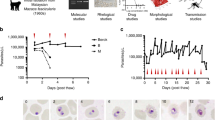Abstract
Continuous culture of the erythrocytic cycle ofPlasmodium falciparum within human erythrocytes maintained under appropriate conditionsin vitro has facilitated a large body of fundamental investigations with this important pathogen. It has revealed complex relationships between the developing intracellular parasite and its host erythrocyte. In pursuit of further understanding of these relationships, we have now developed, and here describe, methods that support extracellular development of the erythrocytic stages ofP. falciparum. Since only 1 to 2% of an inoculum of free merozoites can develop extracellularly through the entire schizogonic cycle to again form merozoites, the method does not support continuous extracellular culture. The work shows that the parasitophorous membrane and vacuole are not essential. Development of the parasites beyond the ring stage does however require constituents of the erythrocyte membrane.
Similar content being viewed by others
Abbreviations
- CPD:
-
citrate-phosphate dextrose
- KIS:
-
KI medium with 10% human serum
- RP-C:
-
RP medium without bicarbonate or serum
- RPS:
-
RP medium with bicarbonate and serum
References
Garnham PCC (1966). Malaria parasites and other haemosporidia. Oxford: Blackwell.
Young MD, Baerg DC, Rossan RN (1975). Parasitological review: Experimental monkey hosts for human plasmodia. Exp Parasitol 38: 136–152.
Trager W, Jensen JB (1976). Human malaria parasites in continuous culture. Science 193: 673–675.
Wernsdorfer WH, McGregor I, eds. (1988) Malaria: Principles and practice of malariology. Edinburgh: Churchill Livingstone, 912 pp.
Trager W (1994). Cultivation of malaria parasites. In: Russell DG (ed), Methods in cell biology. New York: Academic Press (vol 45), pp 7–26.
Wu Y, Sifri CD, Lei HH, Su XZ, Wellems TE (1995). Transfection ofPlasmodium falciparum within human red blood cells. Proc Natl Acad Sci USA 92: 973–977.
Howard RJ (1987). Antigenic variation and antigenic diversity in malaria. Microbiol Immunol 8: 176–218.
Trager W, Zung J, Tershakovec M (1990). Initial extracellular development in vitro of erythrocytic stages of malaria parasites (Plasmodium falciparum). Proc Natl Acad Sci USA 87: 5618–5622.
Trager W, Williams J (1992). Extracellular (axenic) development in vitro of the erythrocytic cycle of Plasmodium falciparum. Proc Natl Acad Sci USA 89: 5351–5355.
Williams JH, Gill GS, Trager W (1995). Effect of erythrocyte membranes on the extracellular development ofPlasmodium falciparum. Proc Natl Acad Sci USA 89: 5351–5355.
Trager W, Williams J, Gill GS (1992). Extracellular development in vitro of the erythrocytic cycle of Plasmodium falciparum. Parasitol Today 8: 384–387.
Bhasin VK, Trager W (1984). Gametocyte-forming and non-gametocyte-forming clones ofPlasmodium falciparum. Am J Trop Med Hyg 33: 534–537.
Lambros C, Vanderberg JP (1979). Synchronization ofPlasmodium falciparum erythrocytic stages in culture. J Parasitol 65: 418–420.
Moore GE, Gerner RE, Franklin HA (1967). Culture of normal human leukocytes. JAMA 199: 519–524.
Divo AA, Geary TG, Davis NL, Jensen JB (1985). Nutritional requirements ofPlasmodium falciparum in culture, I: Exogenously supplied dialyzable components necessary for continuous growth. J Protozool 32: 59–64.
Trager W, Brohn FH (1975). Coenzyme A requirement of malaria parasites: Effects of coenzyme A precursors on extracellular development in vitro ofPlasmodium lophurae. Proc Natl Acad Sci USA 72: 1834–1837.
Schulman S, Roth EF, Cheng B, Rybicki AC, Sussman II, Wong M, Wang W, Ranney HM, Nagel RL, Schwartz RS (1990). Growth ofPlasmodium falciparum in human erythrocytes containing abnormal membrane proteins. Proc Natl Acad Sci USA 87: 7339–7343.
Asahi H, Kanazawa T (1994). Continuous cultivation of intraerythrocyticPlasmodium falciparum in a serum-free medium with the use of a growth-promoting factor. Parasitology 109: 397–401.
Author information
Authors and Affiliations
Rights and permissions
About this article
Cite this article
Trager, W., Williams, J. & Gill, G.S. Extracellular development of erythrocytic stages ofPlasmodium falciparum . Methods Cell Sci 18, 219–227 (1996). https://doi.org/10.1007/BF00132887
Accepted:
Issue Date:
DOI: https://doi.org/10.1007/BF00132887




